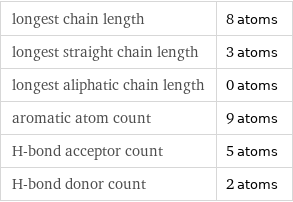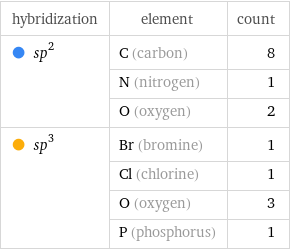Input interpretation

5-bromo-4-chloro-3-indolyl phosphate disodium salt hydrate
Basic properties
![molar mass | 388.4 g/mol formula | C_8H_6BrClNNa_2O_5P empirical formula | O_5Na_2P_C_8N_Cl_Br_H_6 SMILES identifier | C1=CC2=C(C(=CN2)OP(=O)([O-])[O-])C(=C1Br)Cl.[Na+].[Na+].O InChI identifier | InChI=1/C8H6BrClNO4P.2Na.H2O/c9-4-1-2-5-7(8(4)10)6(3-11-5)15-16(12, 13)14;;;/h1-3, 11H, (H2, 12, 13, 14);;;1H2/q;2*+1;/p-2/fC8H4BrClNO4P.2Na.H2O/q-2;2m; InChI key | RXYRFLNEBCZZBF-UHFFFAOYSA-L](../image_source/ad1396f26f16fabf7cf49f2a09649f17.png)
molar mass | 388.4 g/mol formula | C_8H_6BrClNNa_2O_5P empirical formula | O_5Na_2P_C_8N_Cl_Br_H_6 SMILES identifier | C1=CC2=C(C(=CN2)OP(=O)([O-])[O-])C(=C1Br)Cl.[Na+].[Na+].O InChI identifier | InChI=1/C8H6BrClNO4P.2Na.H2O/c9-4-1-2-5-7(8(4)10)6(3-11-5)15-16(12, 13)14;;;/h1-3, 11H, (H2, 12, 13, 14);;;1H2/q;2*+1;/p-2/fC8H4BrClNO4P.2Na.H2O/q-2;2m; InChI key | RXYRFLNEBCZZBF-UHFFFAOYSA-L
Structure diagram

Structure diagram
Quantitative molecular descriptors

longest chain length | 8 atoms longest straight chain length | 3 atoms longest aliphatic chain length | 0 atoms aromatic atom count | 9 atoms H-bond acceptor count | 5 atoms H-bond donor count | 2 atoms
Elemental composition

Find the elemental composition for 5-bromo-4-chloro-3-indolyl phosphate disodium salt hydrate in terms of the atom and mass percents: atom percent = N_i/N_atoms × 100% mass percent = (N_im_i)/m × 100% Plan: • Write the chemical formula and gather atomic masses from the periodic table. • Determine values for N_i, m_i, N_atoms and m using these items. • Finally, compute the percents and check the results. Write the chemical formula: C_8H_6BrClNNa_2O_5P Use the chemical formula to count the number of atoms, N_i, for each element and find the total number of atoms, N_atoms, per molecule: | number of atoms O (oxygen) | 5 Na (sodium) | 2 P (phosphorus) | 1 C (carbon) | 8 N (nitrogen) | 1 Cl (chlorine) | 1 Br (bromine) | 1 H (hydrogen) | 6 N_atoms = 5 + 2 + 1 + 8 + 1 + 1 + 1 + 6 = 25 Divide each N_i by N_atoms to calculate atom fractions. Then use the property that atom fractions must sum to one to check the work: | number of atoms | atom fraction O (oxygen) | 5 | 5/25 Na (sodium) | 2 | 2/25 P (phosphorus) | 1 | 1/25 C (carbon) | 8 | 8/25 N (nitrogen) | 1 | 1/25 Cl (chlorine) | 1 | 1/25 Br (bromine) | 1 | 1/25 H (hydrogen) | 6 | 6/25 Check: 5/25 + 2/25 + 1/25 + 8/25 + 1/25 + 1/25 + 1/25 + 6/25 = 1 Compute atom percents using the atom fractions: | number of atoms | atom percent O (oxygen) | 5 | 5/25 × 100% = 20.0% Na (sodium) | 2 | 2/25 × 100% = 8.00% P (phosphorus) | 1 | 1/25 × 100% = 4.00% C (carbon) | 8 | 8/25 × 100% = 32.0% N (nitrogen) | 1 | 1/25 × 100% = 4.00% Cl (chlorine) | 1 | 1/25 × 100% = 4.00% Br (bromine) | 1 | 1/25 × 100% = 4.00% H (hydrogen) | 6 | 6/25 × 100% = 24.0% Look up the atomic mass, m_i, in unified atomic mass units, u, for each element in the periodic table: | number of atoms | atom percent | atomic mass/u O (oxygen) | 5 | 20.0% | 15.999 Na (sodium) | 2 | 8.00% | 22.98976928 P (phosphorus) | 1 | 4.00% | 30.973761998 C (carbon) | 8 | 32.0% | 12.011 N (nitrogen) | 1 | 4.00% | 14.007 Cl (chlorine) | 1 | 4.00% | 35.45 Br (bromine) | 1 | 4.00% | 79.904 H (hydrogen) | 6 | 24.0% | 1.008 Multiply N_i by m_i to compute the mass for each element. Then sum those values to compute the molecular mass, m: | number of atoms | atom percent | atomic mass/u | mass/u O (oxygen) | 5 | 20.0% | 15.999 | 5 × 15.999 = 79.995 Na (sodium) | 2 | 8.00% | 22.98976928 | 2 × 22.98976928 = 45.97953856 P (phosphorus) | 1 | 4.00% | 30.973761998 | 1 × 30.973761998 = 30.973761998 C (carbon) | 8 | 32.0% | 12.011 | 8 × 12.011 = 96.088 N (nitrogen) | 1 | 4.00% | 14.007 | 1 × 14.007 = 14.007 Cl (chlorine) | 1 | 4.00% | 35.45 | 1 × 35.45 = 35.45 Br (bromine) | 1 | 4.00% | 79.904 | 1 × 79.904 = 79.904 H (hydrogen) | 6 | 24.0% | 1.008 | 6 × 1.008 = 6.048 m = 79.995 u + 45.97953856 u + 30.973761998 u + 96.088 u + 14.007 u + 35.45 u + 79.904 u + 6.048 u = 388.445300558 u Divide the mass for each element by m to calculate mass fractions. Then use the property that mass fractions must sum to one to check the work: | number of atoms | atom percent | mass fraction O (oxygen) | 5 | 20.0% | 79.995/388.445300558 Na (sodium) | 2 | 8.00% | 45.97953856/388.445300558 P (phosphorus) | 1 | 4.00% | 30.973761998/388.445300558 C (carbon) | 8 | 32.0% | 96.088/388.445300558 N (nitrogen) | 1 | 4.00% | 14.007/388.445300558 Cl (chlorine) | 1 | 4.00% | 35.45/388.445300558 Br (bromine) | 1 | 4.00% | 79.904/388.445300558 H (hydrogen) | 6 | 24.0% | 6.048/388.445300558 Check: 79.995/388.445300558 + 45.97953856/388.445300558 + 30.973761998/388.445300558 + 96.088/388.445300558 + 14.007/388.445300558 + 35.45/388.445300558 + 79.904/388.445300558 + 6.048/388.445300558 = 1 Compute mass percents using the mass fractions: Answer: | | | number of atoms | atom percent | mass percent O (oxygen) | 5 | 20.0% | 79.995/388.445300558 × 100% = 20.59% Na (sodium) | 2 | 8.00% | 45.97953856/388.445300558 × 100% = 11.84% P (phosphorus) | 1 | 4.00% | 30.973761998/388.445300558 × 100% = 7.974% C (carbon) | 8 | 32.0% | 96.088/388.445300558 × 100% = 24.74% N (nitrogen) | 1 | 4.00% | 14.007/388.445300558 × 100% = 3.606% Cl (chlorine) | 1 | 4.00% | 35.45/388.445300558 × 100% = 9.126% Br (bromine) | 1 | 4.00% | 79.904/388.445300558 × 100% = 20.57% H (hydrogen) | 6 | 24.0% | 6.048/388.445300558 × 100% = 1.557%
Elemental oxidation states

The first step in finding the oxidation states (or oxidation numbers) in 5-bromo-4-chloro-3-indolyl phosphate disodium salt hydrate is to draw the structure diagram. Next set every oxidation number equal to the atom's formal charge: In 5-bromo-4-chloro-3-indolyl phosphate disodium salt hydrate hydrogen is not bonded to a metal with lower electronegativity, so it will have an oxidation state of +1. Any element bonded to hydrogen gains the bonding electrons, decreasing their oxidation state by 1 for every bond: With hydrogen out of the way, look at the remaining bonds. There are 1 bromine-carbon bond, 1 carbon-carbonl bond, 2 carbon-nitrogen bonds, 1 carbon-oxygen bond, 4 oxygen-phosphorus bonds, and 8 carbon-carbon bonds. For each of these bonds, assign the bonding electrons to the most electronegative element. First examine the bromine-carbon bond: element | electronegativity (Pauling scale) | Br | 2.96 | C | 2.55 | | | Since bromine is more electronegative than carbon, the electrons in this bond will go to bromine. Decrease the oxidation number for bromine (by 1 for single bonds, 2 for double bonds, and 3 for triple bonds), and increase the oxidation number for carbon accordingly: Next look at the carbon-carbonl bond: element | electronegativity (Pauling scale) | C | 2.55 | Cl | 3.16 | | | Since chlorine is more electronegative than carbon, the electrons in this bond will go to chlorine: Next look at the carbon-nitrogen bonds: element | electronegativity (Pauling scale) | C | 2.55 | N | 3.04 | | | Since nitrogen is more electronegative than carbon, the electrons in these bonds will go to nitrogen: Next look at the carbon-oxygen bond: element | electronegativity (Pauling scale) | C | 2.55 | O | 3.44 | | | Since oxygen is more electronegative than carbon, the electrons in this bond will go to oxygen: Next look at the oxygen-phosphorus bonds: element | electronegativity (Pauling scale) | O | 3.44 | P | 2.19 | | | Since oxygen is more electronegative than phosphorus, the electrons in these bonds will go to oxygen: Next look at the carbon-carbon bonds: element | electronegativity (Pauling scale) | C | 2.55 | C | 2.55 | | | Since these elements are the same the bonding electrons are shared equally, and there is no change to the oxidation states: Now summarize the results: Answer: | | oxidation state | element | count -3 | N (nitrogen) | 1 -2 | O (oxygen) | 5 -1 | Br (bromine) | 1 | C (carbon) | 2 | Cl (chlorine) | 1 0 | C (carbon) | 2 +1 | C (carbon) | 4 | H (hydrogen) | 6 | Na (sodium) | 2 +5 | P (phosphorus) | 1
Orbital hybridization

hybridization | element | count sp^2 | C (carbon) | 8 | N (nitrogen) | 1 | O (oxygen) | 2 sp^3 | Br (bromine) | 1 | Cl (chlorine) | 1 | O (oxygen) | 3 | P (phosphorus) | 1
Structure diagram

Orbital hybridization Structure diagram
Topological indices

vertex count | 25 edge count | 23 Schultz index | Wiener index | Hosoya index | Balaban index |